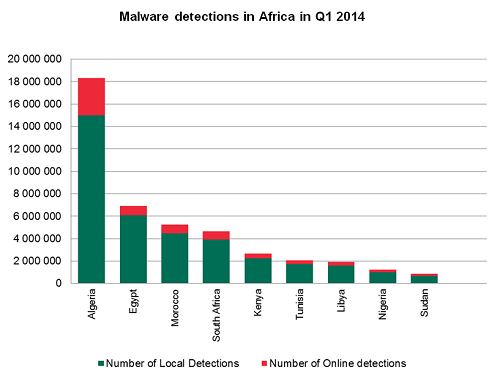As well as reporting on global IT threats, Kaspersky Lab also presented statistics for Africa in the first quarter of 2014 based on data from Kaspersky Security Network.
As well as reporting on global IT threats, Kaspersky Lab also presented statistics for Africa in the first quarter of 2014 based on data from Kaspersky Security Network. Algeria leads in terms of local and web threats, well ahead of Egypt in second place. South Africa followed by Kenya saw a significant number of security incidents, though the number of users affected is one of the lowest in the region. Africa accounted for 4% of total security incidents worldwide, while the figure for the Middle East region was 3%.
“While mobile and financial malware, advanced persistent threats and web threats are becoming more popular among cybercriminals, removable devices and local networks are still the prime sources of IT risks for users in Africa. Companies and home users should be aware of those risks and take care of their data by using comprehensive security solutions,” said Ghareeb Saad, Senior Security Researcher at Kaspersky Lab.
Altogether in the first quarter of 2014 Kaspersky Lab products neutralized more than 49 million cyber-attacks and malware infections on computers and mobile devices of users in Africa. This is a slight decrease compared to the number of incidents reported during January-March of 2013 (52.4 million). Kaspersky Lab saw a significant increase in the number of cyber-attacks and malware infections throughout 2013 (214 million compared to 140 million in 2012).
Regional Kaspersky Security Network statistics show that Algeria has the highest level of both local threats (coming from local networks, USBs, CDs and DVDs, etc.) and web threats - 18.3 million cyber security incidents in total. 54.5% of users in this country encountered local threats and 31.6% faced online threats.
There were over 4.6 million cyber-attacks and malware infections on the computers and mobile devices of users in South Africa, which was approximately 10% of the region’s total number. 3.89 million of those incidents were associated with local threats. Though the number of threats in South Africa is average for the region, the number of users involved is low: 29.6% faced local threats and just 15.4% of users faced web-borne threats during first quarter of 2014. This places South Africa 130th worldwide when it comes to local threats and 141st in terms of web-related threats.
The most popular malware used by cybercriminals in the region in the first quarter – the Dinihou Worm – was responsible for approximately 3 million infections (similar to the situation in the Middle East region). It spreads through removable media devices making use of .LNK files. The most frequently exploited vulnerabilities were breaches in VLC Media Player. There were also numerous incidents of security holes in Oracle Java being exploited in South Africa.
Kaspersky Lab’s global report on the evolution of IT threats in the first quarter of 2014 can be found online at: http://www.securelist.com/en/analysis/204792332/IT_threat_evolution_Q1_2014.
A real-time cyber threat map is available at: http://cybermap.kaspersky.com/
Check your computer with a free computer security scan at: http://free.kaspersky.com/






